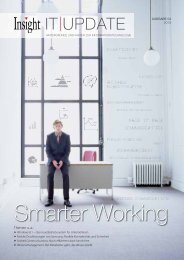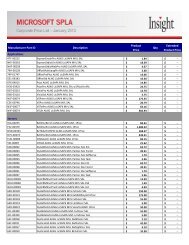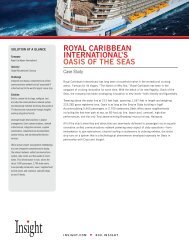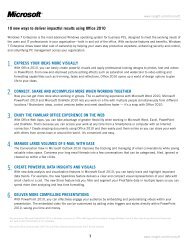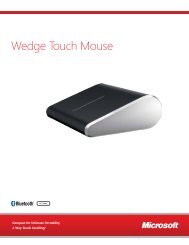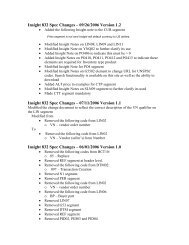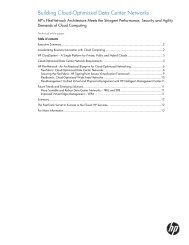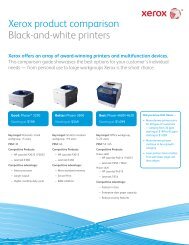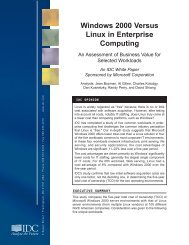EMC Guarantees 20% Capacity Advantage for its Celerra Unified ...
EMC Guarantees 20% Capacity Advantage for its Celerra Unified ...
EMC Guarantees 20% Capacity Advantage for its Celerra Unified ...
Create successful ePaper yourself
Turn your PDF publications into a flip-book with our unique Google optimized e-Paper software.
Company Brief<br />
<strong>EMC</strong> <strong>Guarantees</strong> <strong>20%</strong> <strong>Capacity</strong> <strong>Advantage</strong> <strong>for</strong> <strong>its</strong> <strong>Unified</strong><br />
Storage Systems<br />
Date: June 2010 Author: Mark Peters, Senior Analyst<br />
Abstract: <strong>Guarantees</strong> are often used by emerging vendors because they have to; when market leaders do so, it’s<br />
invariably because they want to. <strong>EMC</strong> now says that <strong>its</strong> customers will need <strong>20%</strong> less raw unified storage capacity in<br />
NAS and/or SAN configurations than they’ll need from the competition. Furthermore, <strong>EMC</strong> has recently announced<br />
features (due this summer) that make this guarantee appear to be just the start of a far broader initiative. <strong>EMC</strong> is<br />
aiming to drive simplicity and efficiency as core customer values. In so doing, <strong>EMC</strong> is clearly challenging <strong>its</strong><br />
competitors and is thereby guaranteeing not only this <strong>20%</strong> differential, but also ensuring a market environment that<br />
will likely generate enhanced value <strong>for</strong> many customers over the coming months.<br />
The <strong>EMC</strong> Guarantee<br />
For many years, the total amount of storage users needed to support application and file environments wasn’t often a<br />
prime IT concern. The amount of raw storage needed to generate a given amount of usable storage was just math;<br />
utilization was known, but it didn’t really drive buying behavior. You just bought more when you needed it because<br />
getting the job done was all that mattered. The sheer growth of data and recent economic concerns have combined to<br />
change that; while getting the job done—effectiveness—is still, of course, crucial, doing it as efficiently as possible is now<br />
equally crucial in most IT organizations. <strong>EMC</strong> has just made a noticeable move in this arena.<br />
The <strong>Unified</strong> Storage Guarantee: In a nutshell, <strong>EMC</strong> has announced that users can achieve any given level of usable<br />
storage space, yet use <strong>20%</strong> less raw storage capacity on <strong>its</strong> unified storage plat<strong>for</strong>m (file and/or block) than with a<br />
competitive plat<strong>for</strong>m. How does it work? Users don’t need to run bake-offs on site—instead, the program is based on a<br />
capacity calculator tool <strong>EMC</strong> has developed, which <strong>its</strong>elf is based on published specifications and—where possible—both<br />
<strong>its</strong> own and competitive best practices. If the tool doesn’t show a <strong>20%</strong> advantage over the competitive solution, <strong>EMC</strong><br />
will make up the difference at no charge to the customer. In terms of details (the “nitty gritty” as <strong>EMC</strong> calls it), the<br />
guarantee applies to all <strong>EMC</strong> unified storage arrays and is aimed at “out of the box” configurations, with no caveats on<br />
the types of data customers will store.<br />
Evaluating the Guarantee: <strong>EMC</strong> certainly has a plethora of analysis and background available to support <strong>its</strong> claim. The<br />
claim is based on having an architectural approach that avoids some of the capacity reservation requirements of <strong>its</strong><br />
competitors <strong>for</strong> common functions such as snapshots and deduplication. As one might expect in such a competitive<br />
market, <strong>EMC</strong>’s language is typically assertive. Its web page states:<br />
“Efficiency is one of <strong>EMC</strong>’s fundamental strengths. Even though our competitors try to match it by<br />
altering their systems, turning off options, changing defaults, or tweaking configurations – no amount of<br />
adjustments can counter the <strong>EMC</strong> unified storage advantage.”<br />
Although ESG has not <strong>for</strong>mally verified the approach, the logic looks sound; however, of course, there is no point beating<br />
one’s head against a wall on the mathematical niceties. Since this is a guarantee, and since it is backed by <strong>EMC</strong>, a<br />
customer can’t lose. Unless <strong>EMC</strong> is embarking on a path to deliberately give away additional capacity, we can assume<br />
that there is indeed an achievable value here. There is little more to say about the guarantee <strong>its</strong>elf; <strong>EMC</strong> is making a<br />
strong market play and is putting <strong>its</strong> money where <strong>its</strong> mouth is. Two rather more interesting questions are these:<br />
How relevant is <strong>EMC</strong>’s position in today’s market environment?<br />
Is this guarantee just a one-off positioning battle or is it an early indication of a bigger war to come?<br />
© 2010 Enterprise Strategy Group, Inc. All Rights Reserved.
Company Brief: <strong>EMC</strong> <strong>Guarantees</strong> <strong>20%</strong> <strong>Capacity</strong> <strong>Advantage</strong> <strong>for</strong> <strong>its</strong> <strong>Unified</strong> Storage Systems 2<br />
User and Market Relevance<br />
The market relevance of using <strong>20%</strong> less capacity is extremely easy to determine and it goes to the heart of the efficiency<br />
need highlighted in the introduction to this paper. While using <strong>20%</strong> less capacity is inherently good (as long as<br />
effectiveness is at least maintained) and while it would mean less equipment has to be bought (an obviously good thing<br />
<strong>for</strong> users), it is also a means to an end. That end is to reduce IT operational expenditures. Specifically, <strong>20%</strong> less disk<br />
capacity means less power consumption, less cooling needed, less floor space required, less maintenance, and even<br />
potentially less management overhead; in other words, less operational expense to get the same work done. And that<br />
matters a lot: as ESG’s latest 2010 Spending Intentions survey data in Figure 1 shows, OPEX reduction is the current<br />
number one consideration in justifying IT investments, ahead of even CAPEX reduction. 1<br />
Figure 1. OPEX Reduction Remains the Top Consideration in Justifying IT Investment <strong>for</strong> 2010-11<br />
Which of the following considerations do you believe will be most important in<br />
justifying IT investments to your organization’s business management team over the<br />
next 12-18 months? (Percent of respondents, three responses accepted)<br />
Reduction in operational costs<br />
Business process improvement<br />
Reduction in capital costs<br />
Improved security / risk management<br />
Return on investment / speed of<br />
payback<br />
Improved regulatory compliance<br />
Reduced time to market <strong>for</strong> our<br />
products or services<br />
10%<br />
<strong>20%</strong><br />
23%<br />
32%<br />
36%<br />
31%<br />
33%<br />
Source: Enterprise Strategy Group, 2010.<br />
There are other insights as to why using <strong>20%</strong> less capacity is not only inherently good, but also particularly relevant:<br />
When asked about their greatest challenge with respect to their storage environments, users’ responses<br />
were surprisingly basic, even arcane: the top challenges were not things like the growth of unstructured<br />
data, per<strong>for</strong>mance, or e-discovery—all these were important and made the list—the number one challenge<br />
was “storage system costs,” number two was “keeping pace with overall data growth,” and number four<br />
was “running out of physical space.”<br />
Responding to a question about areas <strong>for</strong> the most significant data storage investments in 2010-11,<br />
respondents had “more SAN implementations” at number one, followed by “data replication <strong>for</strong> offsite DR”<br />
and “storage virtualization” (probably no huge surprises and good <strong>for</strong> <strong>EMC</strong> in any case); however “more<br />
power efficient storage hardware” was a strong number four on the long list of responses and was ahead of<br />
such things as data reduction technologies, tiering, and improved storage management tools.<br />
Clearly, using <strong>20%</strong> less unified storage capacity is an extremely relevant proposition <strong>for</strong> <strong>EMC</strong> to bring to the marketplace.<br />
1<br />
Source: ESG Research Report, 2010 IT Spending Intentions Survey, January 2010. All statistics come from this report unless otherwise cited.<br />
© 2010 Enterprise Strategy Group, Inc. All Rights Reserved.<br />
17%<br />
30%<br />
37%<br />
42%<br />
37%<br />
54%<br />
62%<br />
0% 10% <strong>20%</strong> 30% 40% 50% 60% 70%<br />
2009<br />
(N=492)<br />
2010<br />
(N=515)
Broader Implications<br />
Company Brief: <strong>EMC</strong> <strong>Guarantees</strong> <strong>20%</strong> <strong>Capacity</strong> <strong>Advantage</strong> <strong>for</strong> <strong>its</strong> <strong>Unified</strong> Storage Systems 3<br />
Following on from some of <strong>EMC</strong>’s announcements at <strong>EMC</strong> World (Boston, May 2010), it looks extremely likely that the<br />
relevance of this new guarantee is more likely the opening salvo in a wider campaign than it is a one-off marketing<br />
package. The overbearing importance of economic efficiency is shown in Figure 2. It shows that “cost reduction<br />
initiatives” are not just an aim within IT <strong>its</strong>elf, but are also the most significant business driver impacting IT spending this<br />
year and next.<br />
Figure 2. Business Initiatives Most Affecting IT Spending Decisions 2010-11<br />
Which of the following business initiatives do you believe will have the greatest impact on<br />
your organization’s IT spending decisions over the next 12-18 months? (Percent of<br />
respondents)<br />
Cost reduction initiatives<br />
Business process improvement initiatives<br />
Security/risk management initiatives<br />
Regulatory compliance<br />
Business growth via mergers, acquisitions, or organic expansion<br />
Improved business intelligence and delivery of real-time business<br />
in<strong>for</strong>mation<br />
“Green” initiatives related to energy efficiency and/or reducing<br />
company-wide environmental impact<br />
Research and development innovation/improvement<br />
International expansion<br />
New collaborative tools and business processes utilizing Web 2.0<br />
technologies such as blogs, wikis, social networking services, etc.<br />
16%<br />
13%<br />
13%<br />
9%<br />
12%<br />
14%<br />
22%<br />
18%<br />
21%<br />
23%<br />
© 2010 Enterprise Strategy Group, Inc. All Rights Reserved.<br />
Source: Enterprise Strategy Group, 2010.<br />
This makes the timing and intent of <strong>EMC</strong>’s unified guarantee rather intriguing as much <strong>for</strong> what’s not included as <strong>for</strong><br />
what is. To be specific, the new guarantee is all about “out of the box” value, and it does not take into account the<br />
incremental efficiency gains that will be the result of several features <strong>EMC</strong> is scheduled to make available this summer.<br />
The features include:<br />
19%<br />
18%<br />
25%<br />
30%<br />
24%<br />
27%<br />
31%<br />
35%<br />
Sub-LUN FAST: <strong>EMC</strong>’s Fully Automated Storage Tiering that allows sub-LUN/volume automated, real-time<br />
data migration and placement. This translates as the automated movement of data to the right place rather<br />
than trying to employ either post-event reaction (which will be too late to have the economic benefit that<br />
was desired) or pre-event prediction (which is impossible in dynamic environments). In most IT<br />
environments, perhaps 90% of the user data is “cool” or “cold” and only 10% is “warm” or “hot”—FAST<br />
makes tiering automated and simple. It can reduce overall costs by enabling customers to use more SATA<br />
drives in production workloads.<br />
47%<br />
54%<br />
0% 10% <strong>20%</strong> 30% 40% 50% 60%<br />
2009<br />
(N=492)<br />
2010<br />
(N=515)
Company Brief: <strong>EMC</strong> <strong>Guarantees</strong> <strong>20%</strong> <strong>Capacity</strong> <strong>Advantage</strong> <strong>for</strong> <strong>its</strong> <strong>Unified</strong> Storage Systems 4<br />
FASTCache: The ability to flexibly use all or a percentage of a user’s EFD (Enterprise Flash Drive, <strong>EMC</strong>’s term<br />
<strong>for</strong> SSD) capacity as an extended cache pool. Flash drives can, in other words, be employed—flexibly—as<br />
either an extremely high per<strong>for</strong>mance “tier” of storage <strong>for</strong> a relatively limited capacity or as a tool to provide<br />
a turbo-boost of per<strong>for</strong>mance across an entire storage system. The expectations <strong>for</strong> this capability are not<br />
trivial; although still in <strong>for</strong>mal testing, relatively small FASTCache usage is expected to be able to reduce<br />
backend disk IO by over 60% in medium-to-large VMware View environments, while a medium-to-large<br />
Oracle OLTP environment could reduce <strong>its</strong> storage footprint by 50% and double per<strong>for</strong>mance.<br />
Compression: This will be a tool <strong>for</strong> primary data and it will be an ability that is new in terms of mainstream<br />
use by a major storage vendor. An often overlooked function, data compression can significantly further<br />
reduce storage capacity needs.<br />
While the potential efficiency gains of these new features are themselves dramatic, they will be coupled with other<br />
existing <strong>EMC</strong> capabilities, including Virtual (thin) Provisioning and deduplication (using Data Domain and Avamar).<br />
Looked at in total, it is clear that <strong>EMC</strong> is driving efficiency as a core value <strong>for</strong> <strong>its</strong> mid-tier storage customers. Although<br />
efficiency will be promoted, it will not be at the cost of effectiveness. For example, the use of FASTCache and Sub-LUN<br />
FAST promises improved per<strong>for</strong>mance; this is especially useful <strong>for</strong> demanding and unpredictable environments,<br />
exemplified by virtualized server operations. Combining greater efficiency with improved per<strong>for</strong>mance f<strong>its</strong> exactly with<br />
what IT practitioners—squeezed as they are from all sides—both need and want.<br />
None of the capabilities of these tools are calculated into—or demanded <strong>for</strong>—the <strong>20%</strong> capacity guarantee. This leads to<br />
two main realizations:<br />
The Bigger Truth<br />
Assuming that all the new functionality works as advertised (and there's no reason to believe otherwise),<br />
then it all translates to even more efficiency (value) <strong>for</strong> users; and that <strong>EMC</strong> is priming <strong>for</strong> a bigger market<br />
battle in the months to come.<br />
Rather obviously—whether <strong>for</strong> new or extended <strong>EMC</strong> <strong>Unified</strong> storage users—this makes the current <strong>20%</strong><br />
less capacity guarantee even more alluring because it's almost certainly going to be exceeded in practice.<br />
<strong>EMC</strong>’s new guarantee can be viewed on two levels. Looked at simply <strong>for</strong> what it is, it is attractive (backed as it is by <strong>EMC</strong>)<br />
and also very relevant to help address a common user need: reducing operational expenses. However, taken in<br />
consideration with the efficiency themes and functions coming in July 2010, it is hard to see anything other than the<br />
start of an all-out market battle around simplicity and economic value that will benefit users.<br />
This new guarantee talks specifically about today’s “unified storage.” The larger <strong>EMC</strong> manifestation of unified storage is<br />
<strong>EMC</strong>’s recently announced unified management system: Unisphere. As announced, Unisphere enables both current and<br />
new <strong>EMC</strong> customers to manage block and file storage as one, and we would not be surprised to see object management<br />
following reasonably soon. Given that the new <strong>20%</strong> guarantee appears conservative in light of the new functions arriving<br />
this summer, this all looks like the beginnings of a much broader market campaign.<br />
Of course, <strong>EMC</strong>’s competition will not take this lying down. We can expect furious exchanges and challenges in terms of<br />
which solution is best, but extensive vendor debates and offers around improved efficiency can ultimately only be good<br />
<strong>for</strong> customers. <strong>EMC</strong>’s “<strong>20%</strong> less” move is almost certainly just the first salvo in a much larger engagement focused more<br />
than ever on customer needs. This is, of course, going to make <strong>for</strong> an extremely interesting storage world over the next<br />
year or two—guaranteed!<br />
All trademark names are property of their respective companies. In<strong>for</strong>mation contained in this publication has been obtained by sources The Enterprise Strategy<br />
Group (ESG) considers to be reliable but is not warranted by ESG. This publication may contain opinions of ESG, which are subject to change from time to time. This<br />
publication is copyrighted by The Enterprise Strategy Group, Inc. Any reproduction or redistribution of this publication, in whole or in part, whether in hard-copy<br />
<strong>for</strong>mat, electronically, or otherwise to persons not authorized to receive it, without the express consent of the Enterprise Strategy Group, Inc., is in violation of U.S.<br />
copyright law and will be subject to an action <strong>for</strong> civil damages and, if applicable, criminal prosecution. Should you have any questions, please contact ESG Client<br />
Relations at (508) 482-0188.<br />
© 2010 Enterprise Strategy Group, Inc. All Rights Reserved.



